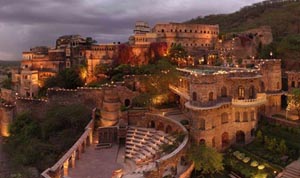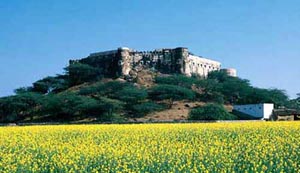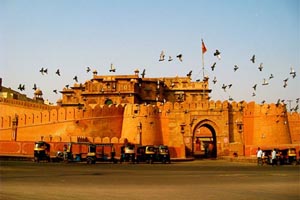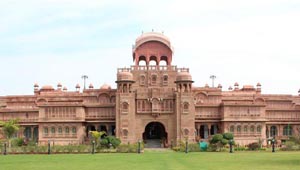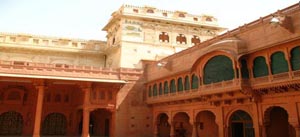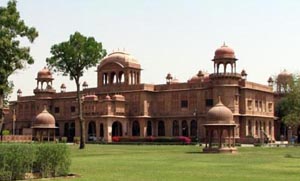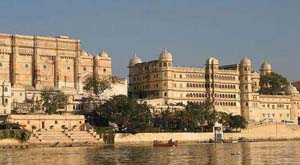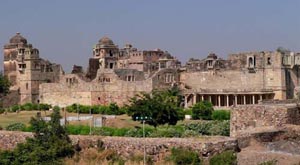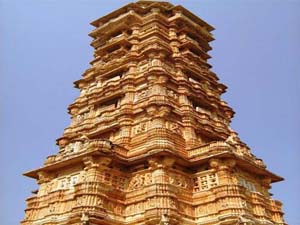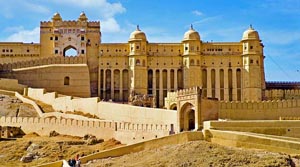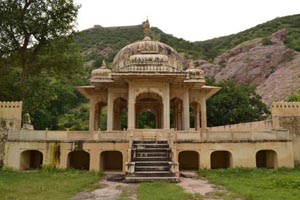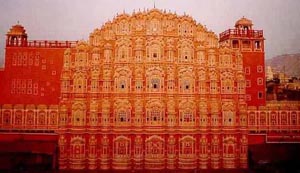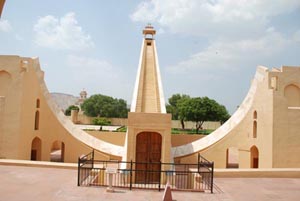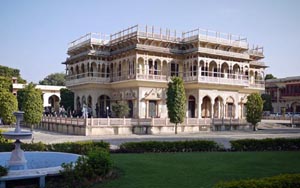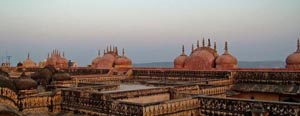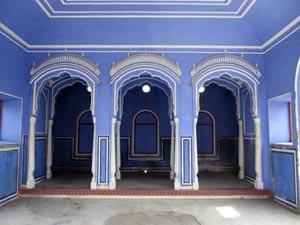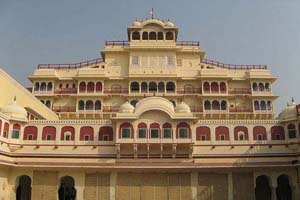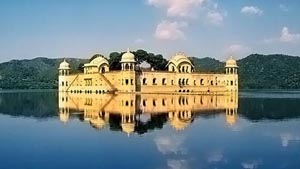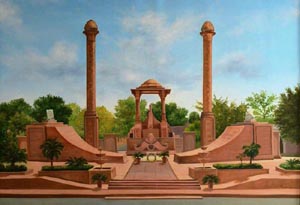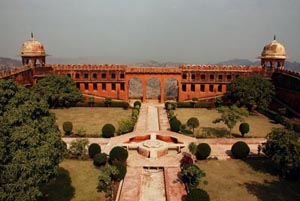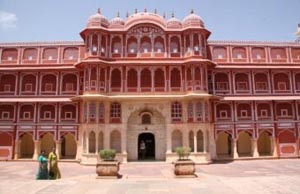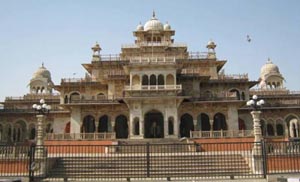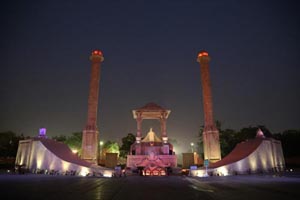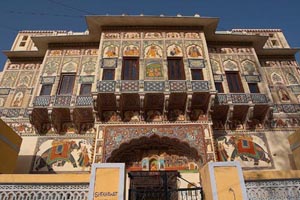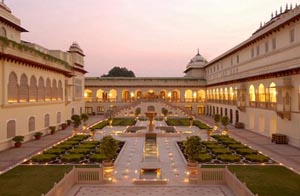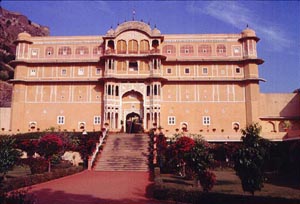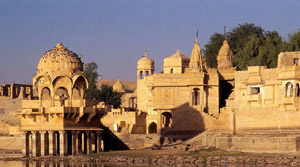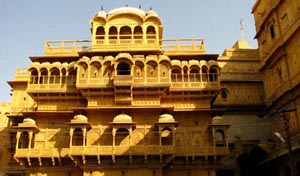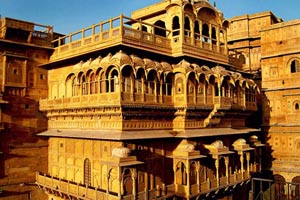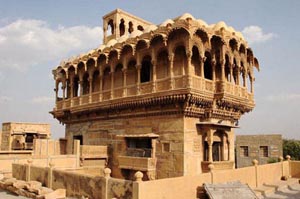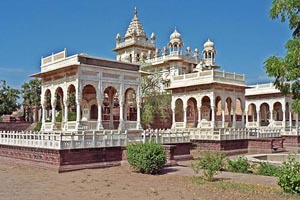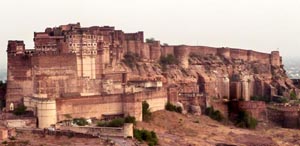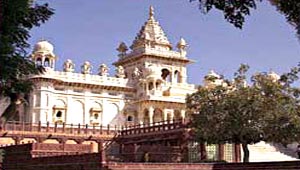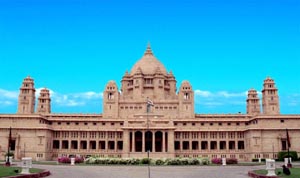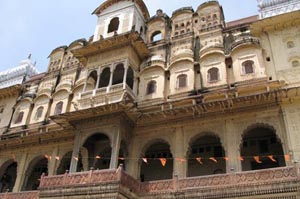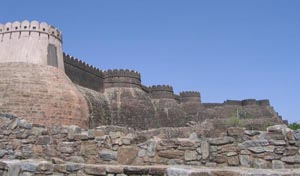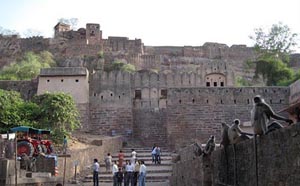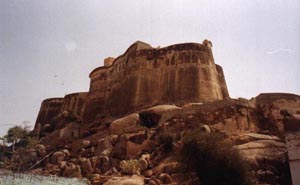Rajasthan Monuments - Famous Historical Places, Forts & Palaces
List of names of Famous Historical Forts / Palaces / Places of Rajasthan State
Here you can find list of names and information on historical forts / palaces/ places / monuments in Rajasthan, India. These famous monuments of Rajasthan state are most visited and most sought after best tourist places. You can also find images of Rajasthan monuments / places / forts / palaces.
Ajmer Monuments, Rajasthan »
Targarh Fort is an ancient hilltop fortress, located at Bundi, Taragarh Town in the Ajmer District of Rajasthan State in the western part of India. It has a record for being the first ever fort to be build on a hilltop in Asia. The great Ajmer City lies beneath this fort. It is surrounded by the Aravali Mountain Ranges. This fort is of Rajput clans and has much historic significance in the history of India.
Alwar Monuments, Rajasthan »
Neemrana Fort Palace is located on the hill top of Neemrana Village, Alwar District of Rajasthan in India. This is one of the oldest forts built in 1464 AD by Raja Dup Raj. This is a large fort and a palace surrounded with scenic beauty. This palace is converted in to a royal luxury hotel from 1986. It serves the world class aristocratic comforts never match by any other heritage hotels in the world.
Hill Fort Kesroli Hill Fort Kesroli is located at Kesroli Village, Near M.I.A., Alwar District of Rajasthan in India. It is a Hilltop Cute fort build in the 14th century by the great Rajasthan Royals. This fort is of historical importance and valued for its architectural works. It is a heritage place and a luxury fort resort catering the needs of domestic and international tourist by Rajasthan Tourism Board.
Bikaner Monuments, Rajasthan »
Gajner Palace is located at Kolayat, Gajner Panchayat, Bikaner City, of Rajasthan State in India. This palace is situated near a lake surrounded by dense forest. This palace is of great place of adventure and scenic beauty. Most of the tourists come here for adventure and to stay in a heritage hotel in the palace, which is a remarkable place for luxury and peace full environment. Bikaner is well connected by Rail, roads and airport.
Junagarh Fort is situated in Bikaner City of Rajasthan State, India. It is located in the western part of India. It is nearby to the beginning of 'Thar Desert', which is the largest desert in India, and Pakistan is just 80 km from here. This is a few old forts built on the land surface. Since, all most many forts have been built on hill top. This fort is built under the design of Mughal architecture and looks very beautiful to see.
Lallgarh palace is a most groovy kind to see. It is located in near Mehron Ka Bas, towards Ganganagar Road, Bikaner, Rajasthan State in India. This was built by 'Maharaja Ganga Singh' in 1926 AD. Still the princely Rajputs decedents reside in this palace in a partial complex. It is an endearing palace of its kind one must visit. Bikarner is a significant tourist place. Rajasthan is located on the western part of India, which has the largest desert front lining up with Pakistan border.
Prachina Museum is an initiative taken by the royal 'Rathor' family descendent to preserve the cultural values of 'Rathors' in Rajasthan in the year 2000. It was established by the daughter of late king 'Narander Sing Ji' named Siddhi Kumari. She founded this museum as a cultural centre for learning arts and crafts. It is situated within the 'Junagarh Fort' premises. This fort is in Bikaner city of Rajasthan State, India.
Sadul Museum is a value of arts and crafts owned by Rajput clans. This museum is on the first floor of Lalgarh Palace, situated in Bikaner City, Rajasthan State of India. Since 1972 AD, the Rajasthan Archeological department and Tourism Development Authority came forward to preserve its national monuments and opened the Sadul Museum to preserve the Rajaputana treasures. To reach here one can travel from the nearest connector junctions like the New Delhi to Bikaner.
Chittorgarh Monuments, Rajasthan »
Fateh Prakash Palace Museum has the largest collection of antiquities used by the Rajput kingdom. This museum was set up in the year 1968 by the archeological department of Rajasthan and named it after the great Rajput ruler Fateh Singh. It is split in many art galleries and sections chronologically inside the museum. There are many stone sculptures on display here, which are basically the ditties of Hindu Gods.
Rana Kumbha Palace was built on a ruined palace built in the 734 AD. The new palace was built here by the great Maharaja Kumbha from the period of 1433 AD to the 1468 AD. He was known for his art and cultural patronages in Rajasthan's Mewar Dynasty. This palace was in the attack of Ala-ud-din Khilji of Khilji Dynasty of Northern part of India, in the year 1303 AD. This attack and capturing of Maharana made the Maharani Padmini and a set of women's in this palace committed Jauhar a custom in Rajasthan.
Vijay Stambh found in Chittorgarh are a very rear in India. It stood as a pride for the Rajputana Kingdom in Rajasthan. It was built around 1442 AD. The historians do believe that it was the pride over defeating an Islamic ruler of that time which was dreaming for the western expansion. At this time the Khilji Dynasty had the Northern, Eastern and Central India in its territory. The west ward approach was stopped by Rajput king Rana Kumbha.
Jaipur Monuments, Rajasthan »
Amber Fort, which is also termed as Amer Fort/Palace is one of the most well-known forts of Jaipur. The fort was established in the year 1592 by Raja Man Singh. It is a major tourist attraction in Jaipur area. Basically, Amber Fort is famous for its creative appearance, having large walls, series of entrances and cobbled pathways. It contains various castles, gardens and lakes among others.
Gaitore is a cenotaph berth for the Rajasthan royal families. It is on the way to 'Amar' a 15 km distance from Jaipur city, Rajasthan, India. This is an historical place to visit. It is a crematorium and a resting place of many Rajput Kings. Here 'Maharaja Jai Singh II' is laid to rest, and his tomb is an esthetic work on marbles. The crematorium place looks like a huge temple from outside.
Hawa Mahal or the wind palace is situated in the pink city of Bada Choupad area, Jaipur, Rajasthan, India. It is a magnificent monument built in 1799 Ad by the Rajput King 'Maharaja Pratap Sigh'. This kind of structure is of rare kind in the world. The specialty of this structure is it enables cool wind in the hot weather conditions. Or one can feel cool environment throughout the year in this monument. So is called the palace of wind. It is a major tourist attraction place in Jaipur.
Jantar Mantar of Jaipur is an astronomical prediction point on earth by man made. Its accuracy is plus or minus two minutes. It is one of the most tumid observatories ever built in the world. The name 'Jantar Mantar' means instrumental formula. It was built in 1727 by the great Rajasthan Royal King Jai Singh Maharaja II, who belongs to 'Rajput clans'. He was an armature astronomer in his time and his desire to popularize geometry was his motive behind the construction of this modern observatory.
Mubarak Mahal is the first building of the City Palace and is closely associated with history of Jaipur city. Mubarak Mahal stands in the central of courtyard of City Palace, which was established during the sovereignty of Sawai Jai Singh from the period of 1699 to 1744. He changed the capital from Amber to Jaipur in the year 1727 due to population growth and growing water shortage. He planned to develop Jaipur city in six areas detached by comprehensive paths and one of the example of this development is Mubarak Mahal.
Nahargarh Fort is in Jaipur, Rajashtan India. This fort is on the foot hills of 'Arravali Hill' range. The Royal Rajasthan is famous for their Royal patronage to maintain a heritage history by the 'Rajput clans'. This fort is also one of the greatest places to visit in Jaipur. This fort is built on 1734 Ad by the Royal King Maharaja Jai Singh II of Rajasthan. This fort is connected to the 'Jaigarh Fort' by a large path way on elevation, which is adjacent to wards it.
Badal Mahal is in Jaipur city of Rajasthan State in India. Rajasthan is the place for forts and palaces. The Badal Mahal is one of the palaces situated in the city palace complex. The meaning of Badal Mahal is 'Cloud Palace' in English. Since the interior of the palace is motley of Blue and white color backgrounds. This palace has a cloud like illusion when seen from far away and by coming near to it; this will be seen as a sketch of designs.
Chandra Mahal is located in the heart of the Jaipur city, Rajasthan State in India. It is a capital palace in the Jaipur city, built by 'Maharaja Jai Sing Ji' of Rajput kingdom. This Mahal was built in the period of 1729 AD to 1732 AD. The meaning of Chandra Mahal in English is 'Moon palace'. Currently this palace is opened as a museum on the ground floor and the royal decedents reside on the other floors of this palace.
Jal Mahal is a lake palace in Man Sagar Lake situated in Ashok Nagar, Jaipur City of Rajasthan State in India. It is the most amazing palace to be visited in Rajasthan. This palace is built on the center of a lake, a beautiful structure floating in the water with the back drop of Nahargarh Hills. The shadow of the hills in the lake water along with the palace is an awesome natural scenic beauty.
Shaheed Smarak is located near Tilak Nagar, Jaipur City of Rajasthan State in India. It is a historical war memorial built in the memory of the first war of Independence fight in India against 'British Imperial' rule. It is a magnificent structure built in the heart of the city. This tower was reinforced on its first century stigma of its war warriors who sacrificed their life in 'Sepoy Mutiny' with British soldiers in India.
City Palace is the other important historical monument in Jaipur. It is situated at the core of Jaipur. City Palace comprises various other historical architectures such as 'Chandra Mahal' and 'Mubarak Mahal' among others. The palace was established by Sawai Jai Singh who ruled during the period of 1699 to 1744. Nowadays, the palace comprises a privately owned museum, having rich assortment of royal costumes. It also has extensive collection of art and 15th century weapons.
Jaigarh Fort is a royal throttlehold and an important historical monument also termed as 'Fort of Victory'. It is regarded as one of the popular forts in Jaipur city. Jaigarh Fort was established by Maharaja Sawai Jai Singh II in order to reinforce the defence in that area. It is the best specimen of a well-developed fortress. The spectacular design of the fort represents the great Indian historic culture.
Jaipur, the capital city of Rajasthan, offers a variety of pleasures. The city itself is a testimony to the majestic magnificence that breathes through the land. However, Jaipur is made magnificent not only by its names but also by the many structures and monuments, which in other words, make what is Jaipur. One of them is Ridhi Sidhi Pol.
Albert Museum Hall is one of the oldest museums in Rajasthan. The museum is located in the central point of Ram Nivas garden. It was established by Samuel Swinton Jacob and become accessible to the public in the year 1887. King Ram Singh primarily desired the museum to be a town hall, however, his descendant, Madho Singh II decided the building to be a museum in order to demonstrate the art of Jaipur and hence was incorporated as a portion of Ram Nivas garden.
Amar Jawan Jyoti is a memorial establishment that was developed in order to give admiration to the courageousness of Jaipur's mythical martyrs and soldiers. Amar Jawan Jyoti is situated in Vidhyut Nagar and is usually congregated by the local people and tourists. This structure is attractively lit up in the course of evening and exhibit bright change of one vivid colour to other. Amar Jawan Jyoti looks quite stunning when it is observed from Vidhan Sabha.
'Diwan-E-Aam' which is also termed as 'Hall of Public Audience' is a fascinating historical monument of Jaipur. It is a key attraction of 'Mubarak Mahal' yard. Traditionally, the king of Jaipur used 'Diwan-E-Aam' as a place of attending various issues of interests. This monument includes durbars, banquet halls and prisons which were also used by the royal women for viewing various proceedings.
Mandawa is a town situated in 168 kilometre distance from Jaipur. It was founded in mid-18th century. Mandawa town was once occupied by the rich merchant families and they have constructed massive structures for the purpose of living. The town, Mandawa has preserved its Rajastani attraction and splendour. It is characterised by attractive arts and architecture and one of the popular architectures is havelis developed by the rich merchants.
Rambagh Palace is an outstanding monument of Jaipur. It was the former residence of the king of Jaipur and at present it has become a deluxe hotel of Taj Group. This hotel is extensively regarded as one of the best hotels in the world, having every modern luxury facilities and hospitality services. Rambagh Palace is highly desired by numerous celebrities and sports stars all over the world.
Samode Palace is a custom monument of Jaipur established by the honourable feudatory. It has rich history and is popular for its attractive grandeur and prominent construction. Samode Palace retains its traditional attraction and folk sculptures which entices various tourists around the world. The palace is situated with a distance of 40 kilometre north from Jaipur. Presently, it has become a part of Heritage Group hotels.
Jaisalmer Monuments, Rajasthan »
Jaisalmer Fort is located on the foot hills of Trikuta, in Jaislamer Disrtict of Rajasthan State in India. This is the world's ever built largest fortification on the hills. It is a unique identity of the Rajasthan Desert, which have country border front with Pakistan on the western part of India. Jaisalmer is a national and international tourist destination. It can be reached out from the nearest junctions in India, like from Udaipur City its only 314 miles.
Nathmalji Ki Haveli is situated in the spunk of Jaisalmer, Rajasthan State of India. This is a part of Thar Desert region, which has an international border with Pakistan on its west front. Haveli is a Hindi word, which means 'Mansion'. This mansion is in the core of Jaisalmer city; one can go by walk and reach here in few minutes. It is a splendid work of illumination and architect.
Patwon Ki Haveli is the mansion of a rich trader in Jaisalmer. It is situated in Jaisalmer City of Rajasthan State in India. It is a few furlongs from the city and shall reach-out here by a simple walk from its city. It is the Haveli of cracking illustration and expectant architectural works. The word 'Haveli' literally means the 'Mansion'. It is one of the enceinte mansions in Jaisalmer of tourist grandness.
Salim Singh Ki Haveli is located in Thar Desert of Jaisalmer city, Rajasthan State of India. It is very close to the Jaisalmer Railway Station. Haveli is Arabic word, which means the Mansion. This mansion is a 300 year old lovely monument of architectural significance. This is a very important tourist place while touring Rajasthan, which is the only heritage tour destination in India. Locally it is well connected by railways.
Jodhpur Monuments, Rajasthan »
The Jaswant Thada is a 'Mausoleum' in Jodhpur city where the Great king Jaswant Singh was laid to rest. This was built by Sardar Maharaja in 1899 for his remembrance of his great father. It is one of the bright architectural cusps. This is on the way to 'Mehrengarh Fort'. Jodhpur is the major town in Rajasthan of India. This city is well accessed by rail, Road and Flight. It can be travelled from anywhere in India and the nearest metro locations are the Indian Capital 'New Delhi'.
The Mehrangarh fort is in Jodhpur town of Rajashtan, a western state of India. It is built on a citadel which is high around 400 meters above the sea level and has a magnificent view of Jodhpur city, when viewed from the fort. It is one of the biggest forts in India. It was built by the 'Rathor's' .i.e. the rulers of western part of India in the 15th century AD. The foundation to build the fort was laid by 'Rao Jodha' in 1459 and later completed by his successors in a decade of time.
The Rai Ka Bagh Palace is one of the tourist destinations in Rajasthan India. It is located in Jodhpur the second town of Rajasthan, which is a 200 km journey from Jaipur, a 587 km journey from Mumbai and 985 km journey from New Delhi. Jodhpur is on the National Highways connecting Mumbai and New Delhi. A domestic airport is there, which runs daily flights from Mumbai, Jaipur and Delhi on daily service.
The Umaid Bhawan Palace is the royal property of Jodhpur 'Maharaja Umaid Singh' located in the heart of Jodhpur City in Rajasthan State, India. It is one of the largest ever residential places for a royal family in India. It consists of 347 rooms which are well carved and designed with paintings and aristocratic valuables. It is a luxury in its class and one has to visit and feel it.
Kota Monuments, Rajasthan »
Kota Fort is located on the banks of Chambel River in Kota District of Rajasthan State in India. The Kota name itself means the 'Fort', which are commonly seen in these areas. These fortifications were the master foundation of the Rajput Empire building in the Kota District of Rajasthan. This is the place where large numbers of forts are present of the entire Rajasthan State.
Rajsamand Monuments, Rajasthan »
Kumbhalgarh Fort is located near Rajsamand District, Rajasthan State of India. This is a hill fort laid on the great Aravali mountain ranges in the 15the century AD. This fort has world record for its fortification walls, which is considered to be the second largest wall in Asia. This is magnificent fort with many palaces and beautiful temples inside the fortified areas.
Sawai Madhopur Monuments, Rajasthan »
Ranthambore Fort is a hilltop fort situated at Ranathambore Village, Sawai Madhopur District, Rajasthan State in India. This fort was built by the erstwhile rulers known as the Chauhan's in the 10th century AD. This fort has a long standing history as the gate way for the western part of India. This fort is located in a highly preserved bio diversity area in the midst of forest, mountains, rivers and lake that environed this cliff hanging fort.
Sikar Monuments, Rajasthan »
Lakshmangarh Fort is now a private property; it was betrayed to Ram Niwasji, who belongs to a rich family called the Jhunjhunwala's in the year 1960 AD. They were residing here with altering in to modern amenities on the interior of this place. Much care was taken while altering. The outer structures were not tampered, to keep its glory. On the other hand the interior is a mix of royal and modern crafts, which are looking more luxurious now.
- Andaman Nicobar Monuments
- Andhra Pradesh Monuments
- Assam Monuments
- Bihar Monuments
- Chhattisgarh Monuments
- New Delhi Monuments
- Goa Monuments
- Gujarat Monuments
- Haryana Monuments
- Himachal Pradesh Monuments
- Jammu and Kashmir Monuments
- Karnataka Monuments
- Kerala Monuments
- Madhya Pradesh Monuments
- Maharashtra Monuments
- Odisha Monuments
- Punjab Monuments
- Rajasthan Monuments
- Tamil Nadu Monuments
- Telangana Monuments
- Uttar Pradesh Monuments
- West Bengal Monuments

